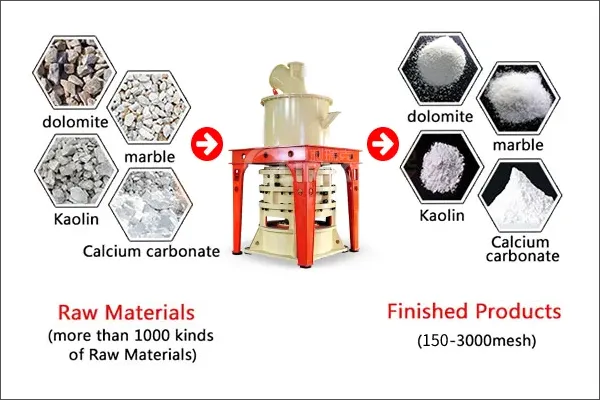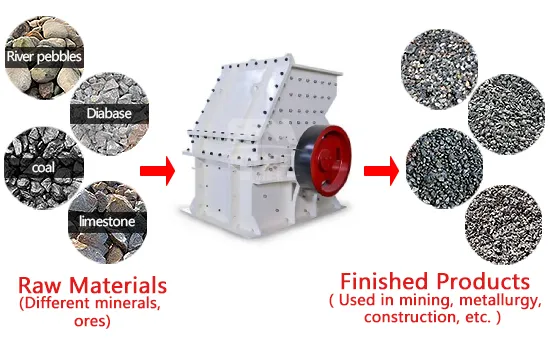The company's main products are HGM series micro pulverizer, superfine micro pulverizer, micro pulverizer, superfine pulverizer, pulverizer and matching hammer crusher, etc.
16/02/2023 admin
Phosphate rock is a phosphorus-containing ore, mostly produced in sedimentary rocks, but also in metamorphic rocks and igneous rocks. Except for individual cases, phosphorus in minerals always exists in the form of orthophosphate, and the main mineral of phosphorus is apatite.
Phosphate rock contains a lot of phosphorus elements, and its uses are mainly to extract phosphorus elements and produce phosphorus-related chemical products. Phosphorus is an important chemical raw material and an essential element for the growth of crops. A large amount of industrial phosphorus must be extracted from phosphate rock to make yellow phosphorus, red phosphorus, phosphoric acid, phosphate fertilizer, and phosphate. There are more industries involved, such as agriculture, chemical industry, textile, glass, ceramics and so on.
Fertilizers: The most common use for phosphate rock is as a source of phosphorus for fertilizers. The ground rock is processed to produce phosphoric acid, which can be used to manufacture a variety of fertilizers, including monoammonium phosphate (MAP), diammonium phosphate (DAP), and triple superphosphate (TSP).
Animal Feed: Phosphate rock can also be used as a source of phosphorus in animal feed, particularly for poultry and livestock. The ground rock is added to feed mixtures to provide the necessary phosphorus for healthy growth and development.
Industrial Applications: Phosphate rock can also be used in a variety of industrial applications, including the production of glass, ceramics, and metal coatings. The ground rock can also be used as a flame retardant or as a component of rust inhibitors.
Water Treatment: Phosphate rock can also be used in water treatment applications, such as the removal of heavy metals from wastewater. The ground rock can be used to adsorb heavy metals, making them easier to remove from the water.
These are some of the most common uses for phosphate rock after it has been ground into a fine powder. The exact use will depend on the properties of the rock and the specific needs of each application.
Mining: The first step in phosphate rock processing is the extraction of the mineral from the earth. This is typically done through open-pit mining or underground mining, depending on the location and quality of the deposit.
Crushing and Grinding: The extracted rock is then crushed and ground into a fine powder to prepare it for further processing.
Beneficiation: The next step in phosphate rock processing is to remove impurities and increase the concentration of the desired minerals. This is done through a variety of methods, including washing, flotation, and magnetic separation.
Concentration: After beneficanting and beneficaling, the concentrate slurry is sent to a separation plant, where the different minerals are separated based on their properties.
Drying: The concentrated minerals are then dried to reduce the moisture content and prepare them for further processing.
Calcination: The dried minerals are then calcined, which involves heating them to high temperatures to remove impurities and to convert the minerals into a form that can be more easily processed.
Sintering: The calcined minerals are then sintered to produce a material with a consistent particle size that is suitable for use in the production of fertilizers.
Granulation: The sintered material is then granulated to form small pellets or granules, which can be easily handled and transported.
This is a general outline of the phosphate rock processing steps, and the exact processes used may vary depending on the specific needs and conditions of each individual operation.
Ball Mills: Ball mills are large cylindrical vessels that are filled with grinding media, such as steel balls or rods. The rock is fed into the mill, and as the mill rotates, the grinding media grinds the rock into a fine powder.

Discharge fineness: 0.075-0.4 mm
Feed size: <25 mm
Output: 1-200 T/H
The ball mill has the characteristics of stable operation, reliable operation, large production capacity and long service life.
Rod Mills: Rod mills are similar to ball mills, but they use long steel rods instead of balls as the grinding media. The rock is fed into the mill and the rods grind it into a fine powder.
Autogenous Mills: Autogenous mills are mills that use the rock itself as the grinding media. The rock is fed into the mill and is ground into a fine powder by the motion of the mill.
Vertical Roller Mills: Vertical roller mills are large grinding machines that use a rotating grinding table to grind the rock into a fine powder. The rock is fed into the top of the mill and is ground between the grinding table and a series of rollers.

Discharge fineness: 80-600 mesh
Feed size: 35 mm
Output: 1-35 t/h

Discharge fineness: 150~3000 mesh
Feed size.: <25 mm
Output: 0.5-45 t/h

Discharge fineness: 150-3000 mesh
Feed size.: <20 mm
Output: 1-20 T/H
Hammer Mills: Hammer mills are high-speed impact mills that are used to grind rock into a fine powder. The rock is fed into the mill and is struck by rapidly rotating hammers, which grind it into a fine powder.

Output Size: 5-20 mm
Feed size: <350 mm
Capacity: 5-30 t/h
These are some of the most commonly used pieces of equipment for grinding phosphate rock. The specific equipment used will depend on the properties of the rock, the desired final product size, and the capacity of the grinding operation.
The fineness of the ground phosphate rock can vary depending on the specific application and desired end product. In general, the fineness of the ground rock is measured by its particle size distribution, which can be determined through techniques such as sieve analysis or laser diffraction.
For fertilizers, the ground rock is typically ground to a particle size of around 90% passing through a 200-mesh screen, which means that 90% of the particles are smaller than 74 microns in size. This fine particle size allows for a more complete reaction with the other components in the fertilizer, resulting in a more effective fertilizer.
For industrial applications, the particle size of the ground rock may be larger or smaller, depending on the specific requirements of the application. For example, for use in glass production, the ground rock may be ground to a particle size of around 95% passing through a 45-mesh screen, while for use in ceramics production, the particle size may be even finer.
The fineness of the ground phosphate rock is an important factor to consider when selecting the appropriate grinding equipment and process, as it affects both the efficiency and effectiveness of the grinding operation.
The prospect for the development and application of phosphate rock is positive, as the demand for phosphate rock is expected to increase in the coming years due to its use in fertilizers and other essential products.
Fertilizer Industry: The demand for phosphate rock is expected to increase as the global population continues to grow and the demand for food increases. This will drive the demand for fertilizers, which are essential for increasing crop yields and improving food security.
Animal Feed: The demand for phosphate rock in the animal feed industry is also expected to increase, as the demand for meat, poultry, and dairy products continues to grow. Phosphate rock is an essential ingredient in animal feed, providing the necessary phosphorus for healthy growth and development.
Industrial Applications: The demand for phosphate rock in industrial applications is expected to continue to grow as well, as it is used in a variety of products, including glass, ceramics, and metal coatings.
Water Treatment: The use of phosphate rock in water treatment applications is also expected to increase, as the need for more effective and environmentally friendly methods for removing heavy metals from wastewater continues to grow.
However, it is important to note that the availability of high-quality phosphate rock resources is limited, and the extraction and processing of phosphate rock can have negative environmental impacts, such as water pollution and the release of greenhouse gases. As a result, the sustainable development and use of phosphate rock will be an important issue in the coming years.
Overall, the prospect for the development and application of phosphate rock is positive, but it will require careful management to ensure that it is used in a sustainable and environmentally responsible manner.
Equipment safety: Milling equipment may break down during use, so it is necessary to check the equipment status regularly to ensure safety.
Process control: The production milling process needs to be strictly controlled to ensure the production quality.
Pollution prevention: During the production process, pollution to the environment should be avoided. If pollution occurs, measures should be taken in time to repair it.
Protect the health of workers: The dust in the production process may cause harm to the health of workers, so it is necessary to take necessary protective measures, such as wearing masks.
Compliance with relevant laws and regulations: The production of phosphate rock grinding powder needs to comply with relevant national and local laws and regulations, such as environmental protection, occupational safety and other aspects involved.
If you have some questions about our products, please feel free to fill out the form below, and we will contact you within 24 hours.